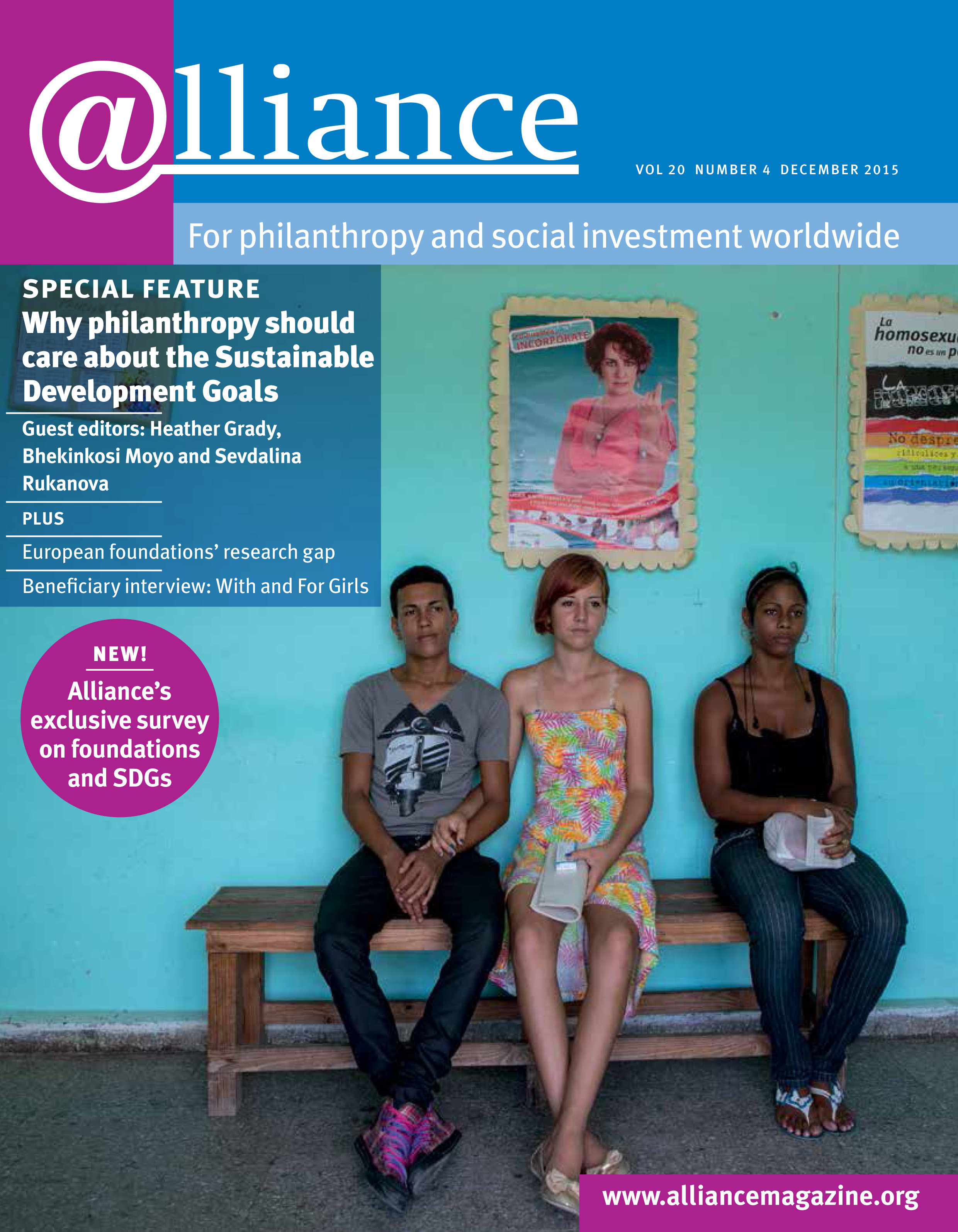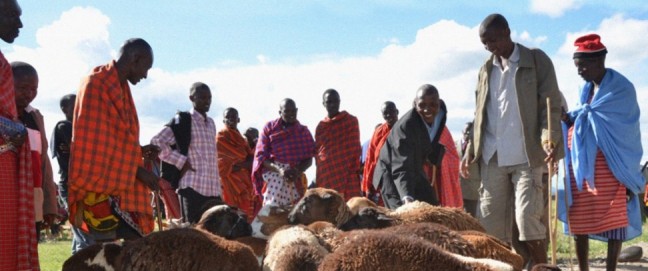The Sustainable Development Goals should concern foundations interested in international development, considering the unprecedented collaborative process by which the goals were negotiated, the political consensus around their adoption, as well as their universality. Moreover, the comprehensive nature of the goals, which tackle poverty, climate change and inequalities, means that many foundations are already working in SDG areas.
The unified vision of development offered by the SDGs will soon be turned into a development manual by many development organizations around the world. They will drive overseas development aid flows in addition to the work of development ministries and government departments around the world.
Some issues remain outstanding, such as selection of indicators to measure progress at both global and country levels. The indicators are due for adoption in March 2016. All governments will be expected to report on their progress starting in 2016, with indicators to keep them accountable. Another discussion is about financing. The goals are expensive – the estimated cost is $3.5 trillion a year in developing countries alone[1].
Approaches that foundations can take
Familiarize yourself with the SDGs
Foundations, especially those interested in collaborating with governments, bilateral agencies, the UN as well as international NGOs, will find connecting and identifying common interests easier if they understand how their own grantmaking fits in the SDG framework. Although the new agenda will be around for the next 15 years, the next two years of the ‘launching phase’ – 2016 and 2017 – will be critical in mobilizing governments and local partners from both public and private sector to collectively discuss what SDGs mean for their countries, how to prioritize, what policies must be adopted to get real traction on the ground, and where resources will come from.
The UN Development Group (UNDG) has developed a common framework to support governments in landing the SDGs in countries. The framework has three elements:
- Supporting countries in aligning national development plans with the SDGs and sensitizing local actors.
- Developing multi-stakeholder partnerships to accelerate finding alternative solutions that advance the SDGs.
- Lending the technical expertise of UN agencies in sustainable development.
Part of this exercise is an outreach to various local stakeholders to sensitize them and engage in dialogues about the SDG implementation. The UN is planning such activities at global as well as country and sub-national levels.
Many bilateral development agencies are already re-thinking their own development cooperation strategies, including options on how to effectively collaborate with others in advancing the SDGs.
‘Diversity of approaches, new actors and blending of resources will drive innovations and progress toward specific goals, and the shared framework of indicators and metrics, will be used to measure progress.’
Connect with development ecosystem and collaborate
The SDGs, much more than their predecessors, the Millennium Development Goals, will require broad‑based partnerships to achieve progress. Collaboration opportunities will be aligned with specific goals and targets. Diversity of approaches, new actors and blending of resources will drive innovations and progress toward specific goals, and the shared framework of indicators and metrics, will be used to measure progress.
As such, the SDGs offer a useful framework for collaboration for foundations. Identifying possible entry points to partnering with like-minded organizations on issues of common concern will be an opportunity to leverage resources. For example, the UNDP, jointly with Rockefeller Philanthropy Advisors and the Foundation Center, established the SDGs Philanthropy Platform with funding from the Conrad N. Hilton Foundation, Ford Foundation and The MasterCard Foundation. The platform assists philanthropy in connecting with the UN, with governments and with local partners in implementing the SDGs. Launched in Kenya, Colombia, Indonesia and Ghana, it works like a compass and helps philanthropy navigate local development ecosystems and orient their own work vis a vis governments, the UN and other bilateral donors in the countries.

The iHub and ICT innovation centre in Nairobi, Kenya. Young people are seen as critical innovators for inclusive and sustainable development.
Credit: UNDP
It connects philanthropic initiatives with the official development cooperation system, such as the UN Development Assistance Framework and development partners’ technical working groups addressing sectoral issues, assisting the formation of concrete collaborations. It offers an opportunity for collective action to scale tried pilot solutions as well as testing new solutions. In the SDG era, where the need for resources is greater than ever, demand will be much greater for ready‑made solutions that can be taken up at national levels.
Share your data
There is little systematic sharing of information on philanthropic activities around the world. It is an important impediment because governments and other potential partners have little understanding of the value and contribution of the sector on development in their own countries. For example, we have discovered thriving philanthropic sectors in countries where the Philanthropy Platform has been launched which pioneer solutions in areas such as education, health or women’s empowerment. However, limited understanding among governments as well as others of these indigenous foundations’ impact inhibits robust local dialogues on an enabling institutional environment for philanthropy.
Collaboration would be much easier if other organizations, including bilateral donors, had more information and access to knowledge of what foundations are investing in and how. It would be easier for foundations to find partners. Moreover, increasing the transparency of the philanthropic sector would contribute to more trust in the sector. The Philanthropy Platform works with local philanthropic organizations to develop the capacities for data sharing as part of the SDGfunders.org open source web portal, which monitors philanthropic investments in the SDGs.
Lead in pioneering pathways to sustainable development
New pathways will be needed in the next two years to show ways out of poverty, what works in reversing trends towards inequalities, as well as strategies to meet other goals. New technologies, approaches, knowledge and resources at a massive scale will be needed to address the huge global challenges.
Philanthropy institutions can build on strengths in leading experimentation with their experience in implementing alternative solutions, their commitment to take risks and availability of discretionary capital, as well as their connections at grassroots levels where testing can happen. To effectively bridge the local with the global, collaboration between large foundations with global scale and local philanthropy will be very much needed.
While global foundations have access to global networks, large resources and an understanding of development processes, local philanthropy offers local insights and has much accumulated experience as well technical expertise about what strategies work in local contexts. Collectively, local foundations are particularly adept at reaching vulnerable people, due to their many years of funding and working with grassroots CSOs and NGOs across countries.
‘To effectively bridge the local with the global, collaboration between large foundations with global scale and local philanthropy will be very much needed.’
For example in Kenya, the platform facilitates a collaboration on education involving The MasterCard Foundation and many indigenous foundations; in Ghana, we are tapping the expertise of the Conrad N. Hilton Foundation as well as of its grantees to address access to water. The Ford Foundation, jointly with AFE, a network of foundations in Colombia, is linking philanthropy to government actions on SDG 16, a new goal covering inclusive and peaceful societies.
During the recent European Grantmakers East Forum in Istanbul, Barry Knight in his closing speech referred to many successful cases of foundations’ long-term commitment in pioneering solutions to social justice. They have left huge legacies that many others are building on today. None of them would be possible without collaboration.
The SDGs are a spectacularly ambitious framework whose goals can be achieved if organizations inspire people around the world to take action. Collaboration is essential.
Collaborative philanthropy has a lot to contribute as an integrator that reaches out and translates this massive framework to the level of individual actions and commitments.
Karolina Mzyk Callias is a policy specialist for foundations at the United Nations Development Programme. Email karolina.mzyk@undp.org
For more information
Learn more about SDG Platform
Follow us on twitter #PhilSDGs
Main image: Schoolchildren in Aceh work on a risk map as part of community awareness plans to reduce disasters. Credit UNDP
For more discussion on the SDG debate, listen to our Alliance Audio podcast.
Footnotes
- ^ UNCTAD, World Investment Report 2014, p140



Comments (0)